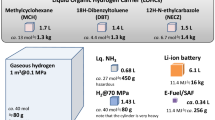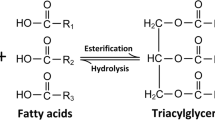Abstract
In order to remedy the environmental pollution caused by oil spills, new materials with gelation capacity of organic solvents and fuels have been synthetized during the recent years. Among them, some of the most promising materials contain amide groups, which are often incorporated into the chemical structure of organogelators due to their effectiveness in gelling organic solvents through hydrogen bonds. A bisamide derivative of hydroxybenzoic acid (Bis-HUB1) was designed and synthesized in two steps and is able to congeal organic solvents. Gelation tests, critical gelation concentrations, and gel-sol transition temperatures were discussed in terms of its supramolecular interactions. Intermolecular hydrogen bonds and π-π stacking were studied through variable-temperature FTIR and UV-visible spectroscopy, while the structural characterization was performed via freeze-fracture TEM. Interestingly, Bis-HUB1 showed the ability to gel gasoline and diesel from monophasic and biphasic systems, which implies its potential use as a remediation agent in fuel spills. The results encourage further research.






Similar content being viewed by others
Data Availability
Not applicable.
References
Babu, S. S., Praveen, V. K., & Ajayaghosh, A. (2014). Functional π-gelators and their applications. Chemical Reviews, 114(4), 1973–2129.
Bachl, J., Oehm, S., Mayr, J., Cativiela, C., Marrero-Tellado, J. J., & Díaz, D. D. (2015). Supramolecular phase-selective gelation by peptides bearing side-chain azobenzenes: Effect of ultrasound and potential for dye removal and oil spill remediation. International Journal of Molecular Sciences, 16(5), 11766–117844.
Basak, S., Nandi, N., Baral, A., & Banerjee, A. (2015). Tailor-made design of J- or H-aggregated naphthalenediimide-based gels and remarkable fluorescence turn on/off behaviour depending on solvents. Chemical Communications, 51(4), 780–783.
Berret, J.-F., Roux, D. C., Porte, G., & Lindner, P. (1994). Shear-induced isotropic-to-nematic phase transition in equilibrium polymers. Europhysics Letters (EPL), 25(7), 521–526.
Bhattacharya, S., & Krishnan-Ghosh, Y. (2001). First report of phase selective gelation of oil from oil/water mixtures. Possible implications toward containing oil spills. Chemical Communications, 2, 185–186.
Breynaert, E., Houlleberghs, M., Radhakrishnan, S., Grübel, G., Taulelle, F., & Martens, J. A. (2020). Water as a tuneable solvent: A perspective. Chemical Society Reviews, 49(9), 2557–2569.
Christ, E., Blanc, C., Al Ouahabi, A., Maurin, D., Le Parc, R., Bantignies, J. L., Guenet, J. M., Collin, D., & Mésini, P. J. (2016). Origin of invariant gel melting temperatures in the c–T phase diagram of an organogel. Langmuir, 32(19), 4975–4982.
Daniels, I. N., Wang, Z., & Laird, B. B. (2017). Dielectric properties of organic solvents in an electric field. The Journal of Physical Chemistry C, 121(2), 1025–1031.
Delbecq, F., Adenier, G., Ogue, Y., & Kawai, T. (2020). Gelation properties of various long chain amidoamines: Prediction of solvent gelation via machine learning using Hansen solubility parameters. Journal of Molecular Liquids, 303, 112587.
Fernando, H., Ju, H., Kakumanu, R., Bhopale, K. K., Croisant, S., Elferink, C., Kaphalia, B. S., & Ansari, G. A. S. (2019). Distribution of petrogenic polycyclic aromatic hydrocarbons (PAHs) in seafood following Deepwater Horizon oil spill. Marine Pollution Bulletin, 145, 200–207.
Gam, K. B., Engel, L. S., Kwok, R. K., Curry, M. D., Stewart, P. A., Stenzel, M. R., McGrath, J. A., Braxton Jackson II, W., Lichtveld M. Y., Sandler, D. P. (2018). Association between Deepwater Horizon oil spill response and cleanup work experiences and lung function, Environment International, 121(part 1), 695–702.
Griffiths, P. C., Knight, D. W., Morgan, I. R., Ford, A., Brown, J., Davies, B., Heenan, R. K., King, S. M., Dalgliesh, R. M., Tomkinson, J., Prescott, S., Schweins, R., & Paul, A. (2010). Gelation or molecular recognition; is the bis-(α,β-dihydroxy ester)s motif an omnigelator? Beilstein Journal of Organic Chemistry, 6, 1079–1088.
Jiao, T. F., Gao, F. Q., Shen, X. H., Zhang, Q. R., Zhang, X. F., Zhou, J. X., & Gao, F. M. (2013). Self-assembly and nanostructures in organogels based on a bolaform cholesteryl imide compound with conjugated aromatic spacer. Materials, 6(12), 5893–5906.
Korshin, G. V., Li, C. W., & Benjamin, M. M. (1997). Monitoring the properties of natural organic matter through UV spectroscopy: A consistent theory. Water Research, 31(7), 1787–1795.
Laffon, B., Pásaro, E., & Valdiglesias, V. (2016). Effects of exposure to oil spills on human health: Updated review. Journal of Toxicology and Environmental Health Part B, 19(3–4), 105–128.
Laupheimer, M., Preisig, N., & Stubenrauch, C. (2015). The molecular organogel n-decane/12-hydroxyoctadecanoic acid: Sol–gel transition, rheology, and microstructure. Colloids and Surfaces A: Physicochemical and Engineering Aspects, 469, 315–325.
Lin, P., Zhang, N. X., Li, J. J., Zhang, J., Liu, J. H., Zhang, B., & Song, J. (2017). To gel or not to gel: A prior prediction of gelation in solvent mixtures. Chinese Chemical Letters, 28(4), 771–776.
Liu, X. Y., & Li, J.-L. (2013). Soft fibrillar materials: Fabrication and applications. Weinheim: John Wiley & Sons.
Malone, J. F., Murray, C. M., Charlton, M. H., Docherty, R., Lavery, A. J. (1997). X-H···π (phenyl) interactions theoretical and crystallographic observations, Journal of the Chemical Society, Faraday Transactions, 93(19), 3429–3436.
Murphy, D., Gemmell, B., Vaccari, L., Li, C., Bacosa, H., Evans, M., Gemmell, C., Harvey, T., Jalali, M., & Niepa, T. H. R. (2016). An in-depth survey of the oil spill literature since 1968: Long term trends and changes since Deepwater Horizon. Marine Pollution Bulletin, 113(1–2), 371–379.
Nazemi, A., He, X., MacFarlane, L. R., Harniman, R. L., Hsiao, M. S., Winnik, M. A., Faul, C. F. J., & Manners, I. (2017). Uniform “patchy” platelets by seeded heteroepitaxial growth of crystallizable polymer blends in two dimensions. Journal of the American Chemical Society, 139(12), 4409–4417.
Ohsedo, Y. (2016). Low-molecular-weight organogelators as functional materials for oil spill remediation. Polymers for Advanced Technologies, 27(6), 704–7011.
Okesola, B. O., & Smith, D. K. (2016). Applying low-molecular weight supramolecular gelators in an environmental setting–Self-assembled gels as smart materials for pollutant removal. Chemical Society Reviews, 45(15), 4226–4251.
Palui, G., Simon, F.-X., Schmutz, M., Mésini, P. J., & Banerjee, A. (2008). Organogelators from self-assembling peptide based dendrimers: Structural and morphological features. Tetrahedron, 64(1), 175–185.
Pasparakis, C., Esbaugh, A. J., Burggren, W., & Grosell, M. (2019). Physiological impacts of Deepwater Horizon oil on fish. Comparative Biochemistry and Physiology Part C: Toxicology & Pharmacology, 224, 108558.
Raju, C. S. K., Pramanik, B., Kar, T., Rao, P. V. C., Choudary, N. V., & Ravishankar, R. (2016). Low molecular weight gels: Potential in remediation of crude oil spillage and recovery. RSC Advances, 6(58), 53415–53420.
Ran, X., Shi, L., Zhang, K., Lou, J., Liu, B., & Guo, L. (2015). The gelation ability and morphology study of organogel system based on calamitic hydrazide derivatives. Journal of Nanomaterials, 2015, 1–6.
Ran, X., Li, Y., Gao, Q., Qiu, W., & Guo, L. (2017). A smart phase-selective gelator for recycling aromatic solvents, the removal of toxic dyes, and molecular delivery. Asian Journal of Organic Chemistry, 6(1), 95–101.
Schmidt, R., Schmutz, M., Michel, M., Decher, G., & Mésini, P. J. (2002). Organogelation properties of a series of oligoamides. Langmuir, 18(15), 5668–5672.
Schmidt, R., Adam, F. B., Michel, M., Schmutz, M., Decher, G., & Mésini, P. J. (2003). New bisamides gelators: Relationship between chemical structure and fiber morphology. Tetrahedron Letters, 44(15), 3171–3174.
Schwing, P. T., Chanton, J. P., Romero, I. C., Hollander, D. J., Goddard, E. A., Brooks, G. R., & Larson, R. A. (2018). Tracing the incorporation of carbon into benthic foraminiferal calcite following the Deepwater Horizon event. Environmental Pollution, 237, 424–429.
Shakeel, A., Farooq, U., Gabriele, D., Marangoni, A. G., & Lupi, F. R. (2020). Bigels and multi-component organogels: An overview from rheological perspective. Food Hydrocolloids, 111, 106190.
Simon, F. X., Nguyen, T. T. T., Díaz, N., Schmutz, M., Demé, B., Jestin, J., & Mésini, P. J. (2013). Self-assembling properties of a series of homologous ester-diamides-From ribbons to nanotubes. Soft Matter, 9(35), 8483–8493.
Steed, J. W., Turner, D. R., & Wallace, K. J. (2007). Core concepts in supramolecular chemistry and nanochemistry. Chichester: John Wiley & Sons.
Suzuki, M., Maruyama, Y., & Hanabusa, K. (2016). Gel-solution phase transition of organogels with photoreversibility: L-amino acid organogelators with azobenzene. Tetrahedron Letters, 57(31), 3540–3543.
Tsai, C. C., Cheng, Y. T., Shen, L. C., Chang, K. C., Ho, I. T., Chu, J. H., & Chung, W. S. (2013). Biscalix[4]arene derivative as a very efficient phase selective gelator for oil spill recovery. Organic Letters, 15(22), 5830–5833.
Vibhute, A. M., & Sureshan, K. M. (2020). How far are we in combating marine oil spills by using phase-selective organogelators? ChemSusChem, 13(20), 5343–5360.
Wise, J. P., Wise, J. T. F., Wise, C. F., Wise, S. S., Gianios, C., Xie, H., & Wise, J. P. (2018). A three year study of metal levels in skin biopsies of whales in the Gulf of Mexico after the Deepwater Horizon oil crisis. Comparative Biochemistry and Physiology Part C: Toxicology & Pharmacology, 205, 15–25.
Yousofi, T., Moradi, Z., Hoshyarmanesh, P., & Rahmati, A. (2020). Synthesis a microporous organic gelator and evaluation of organic solvents gelling properties and the separation of crude oil products from water. Materials Letters, 260, 126909.
Zapién-Castillo, S., Díaz-Zavala, N. P., Melo-Banda, J. A., Schwaller, D., Lamps, J. P., Schmutz, M., Combet, J., & Mésini, P. J. (2020). Structure of nanotubes self-assembled from a monoamide organogelator. International Journal of Molecular Sciences, 21(14), 4960.
Acknowledgments
We would like to acknowledge Institut Charles Sadron for VT-FTIR and freeze-fracture studies and the Consejo Nacional de Ciencia y Tecnología (CONACyT) for the Ph.D. scholarship to Samuel Zapién-Castillo and the Master D. candidate to Jorge J. Montes-Patiño. We would like to thank the TecNM for the reagents and materials provided through the 9573.20-P project.
Author information
Authors and Affiliations
Contributions
Samuel Zapién-Castillo, Nancy P. Díaz-Zavala, Philippe J. Mésini, and Jessica I. Lozano-Navarro conceived and designed the experiments, also analyzed the data, wrote the paper, and revised the written translation of article; Samuel Zapién-Castillo and Jorge J. Montes-Patiño performed the experiments; Josué F. Pérez-Sánchez and José A. Melo-Banda analyzed the data. All authors have read and agreed to the published version of the manuscript.
Corresponding author
Ethics declarations
Conflict of Interest
The authors declare no conflict of interest.
Ethical Approval
Not applicable.
Consent to Participate
Not applicable.
Consent for Publication
Not applicable.
Code Availability
Not applicable.
Additional information
Publisher’s Note
Springer Nature remains neutral with regard to jurisdictional claims in published maps and institutional affiliations.
Rights and permissions
About this article
Cite this article
Zapién-Castillo, S., Montes-Patiño, J.J., Pérez-Sánchez, J.F. et al. Recovery of Fuels Using the Supramolecular Gelation Ability of a Hydroxybenzoic Acid Bisamide Derivative. Water Air Soil Pollut 232, 39 (2021). https://doi.org/10.1007/s11270-021-04991-x
Received:
Accepted:
Published:
DOI: https://doi.org/10.1007/s11270-021-04991-x




